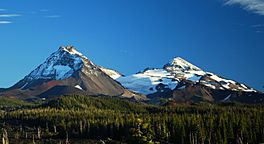Collier Glacier facts for kids
Quick facts for kids Collier Glacier |
|
|---|---|

The Collier Glacier is between North Sister (left) and Middle Sister.
|
|
| Type | Mountain glacier |
| Location | Cascade Range, Lane County, Oregon, U.S. |
| Coordinates | 44°09′54″N 121°47′06″W / 44.16500°N 121.78500°W |
| Length | 5,000 ft (1,500 m) |
| Terminus | Barren rock |
| Status | Retreating |
The Collier Glacier is a cool natural ice formation found in the U.S. state of Oregon. It's located high up in the Cascade Range mountains, usually above 8,000 feet (about 2,400 meters) in elevation. This glacier sits on the western side of North Sister, which is an old, inactive volcano. Over many years, the Collier Glacier has shrunk quite a bit, retreating more than a mile since a period known as the Little Ice Age.
Contents
What is Collier Glacier?
Collier Glacier is a type of glacier called a mountain glacier. These glaciers form in high mountain areas where snow falls and builds up over many years. The weight of the snow presses down, turning the bottom layers into ice. This ice then slowly flows downhill, like a very slow-moving river.
Where is Collier Glacier located?
Collier Glacier is found in the Cascade Range, a large mountain chain that stretches through parts of western North America. Specifically, it's in Lane County, Oregon, in the United States. The glacier is nestled between two tall peaks: North Sister and Middle Sister. These peaks are part of a group of three volcanoes known as the Three Sisters. North Sister is an extinct shield volcano, meaning it hasn't erupted in a very long time and has a wide, gently sloping shape.
How has Collier Glacier changed over time?
Like many glaciers around the world, Collier Glacier has been getting smaller. Scientists study glaciers to understand how Earth's climate is changing. The Collier Glacier has retreated, or melted back, significantly since a period called the Little Ice Age. This means the glacier is not as big as it used to be.
What is the Little Ice Age?
The Little Ice Age was a time when Earth's climate was cooler than it is today. It lasted for several centuries, roughly from the year 1350 to 1850. During this period, glaciers in many parts of the world grew larger because there was more snow and colder temperatures. After the Little Ice Age ended, the climate started to warm up again. This warming has caused many glaciers, including Collier Glacier, to shrink. Studying glaciers helps us learn about past climates and how they might change in the future.


